Lecture V--Aphra Behn and the Proto-novel
Week 5
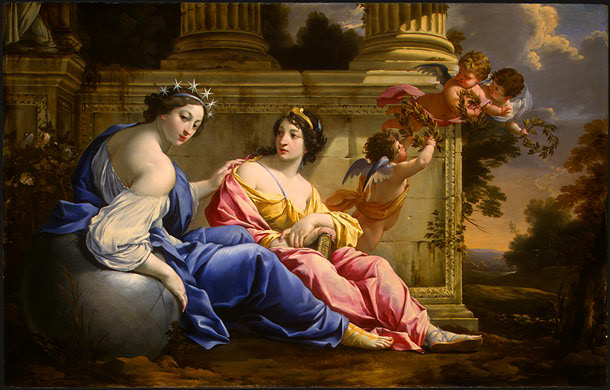
Simon Vouet
The Muses Urania and Calliope, c. 1634
Photos from the Online National Gallery - Blurb for the
Painting
Precocious and widely traveled, Vouet already had worked in London,
Constantinople, and Venice before reaching Rome in 1614. Louis XIII summoned
him back to Paris in 1627 to become chief court artist.
Resting beside a temple to Apollo, the god of creativity, two muses personify
aspects of human knowledge. Urania, the muse of astronomy, wears a diadem of
stars and leans against a celestial globe. The patroness of epic poetry and history,
Calliope is crowned with gold and holds a volume of Homer's Odyssey. Winged
infants or putti carry trophies of achievement - Apollo's laurel wreaths.
The fifth class session will begin an
investigation into other aspects of women's writing. We have looked
at the historical evolution that led to Aphra Behn, talked about her seminal
work. But Behn is also cited as one of the writers who was working in the
form that would become the modern "novel." The novel, actually,
becomes the genre in which women, finally, take a leading role - and there are
some powerful reasons why this form was so useful for female writers.
It might be argued that the Novel provided the perfect
showcase for women. The form arrived at a time that there was a growing
"middle class" readership and expanded access to publishing opportunities. It tended to favor qualities like "realism,"
"plot," social criticism, attention to detail, and the authentic
authorial voice. More importantly, perhaps, the Novel becomes, almost
immediately, a form that will encourage a female heroine.
our music from ARNE, Thomas Augustine (1710-78); Eng.
Midi Sequence by A.F.C. Redman
PREVIEW
Our unknown author of the week: Frances
Trollope

Frances Trollope, the daughter of a clergyman, was born in Hampshire in 1780. When her husband's business failed,
Trollope, who was now fifty-two, began writing books. Her novels were very popular and it was not long before she was able to pay off her husband's debts. Trollope believed that novels should deal with important social issues. Her novel, Jonathan Jefferson
Whitlaw, was about the evils of slavery, and The Vicar of Wrexhill tackled the subject of church corruption.
In 1839 Trollope became involved in the campaign against the employment of children in factories. After visiting several factories in Manchester and Bradford, Trollope wrote Michael Armstrong, the Factory Boy. Francis Trollope was severely
criticized for writing about such "vulgar... and low-bred people". One critic claimed that the novel encouraged people to hate factory owners and suggested that Trollope should be sent to prison for writing such a dangerous book.
Of her novels, The Widow Barnaby and The Widow Married were the most successful. By the time Frances Trollope died in 1863, she had written forty books. Her son Anthony Trollope (1815-1882) was also a successful novelist.
Domestic Manners of the Americans, written during her
travels in America during 1827-1831 gives many first-hand observations of religious revivalism and the conditions
necessary to bring it about.
CINCINNATI, OHIO. 1828. Absence of Amusements; Revivals; Unhappy Influence of Religion on
Women in America.
I never saw any people who appeared to live so much without amusement as the Cincinnatians. Billiards are
forbidden by law, so are cards. To sell a pack of cards in Ohio subjects the seller to a penalty of fifty dollars.
They have no public balls, excepting, I think, six, during the Christmas holidays. They have no concerts. They have no
dinner parties.
They have a theatre, which is, in fact, the only public amusement of this triste little town; put they seem to care little about it, and either from economy or distaste, it is very poorly attended. Ladies are rarely seen there, and by far the larger proportion of females deem it an offence against religion to witness the representation of a play.
It is in the churches and chapels of the town that the ladies are to be seen in full costume: and I am tempted to believe that a stranger from the continent of Europe would be inclined, on first reconnoitering the city, to suppose that the places of worship were the theatres and cafes of the place.
No evening in the week but brings throngs of the young and beautiful to the chapels and meetinghouses, all dressed with care, and sometimes with great pretension; it is there that all display is made, and all fashionable distinction sought.
The proportion of gentlemen attending these evening meetings is very small, but often, as might be expected, a sprinkling of smart young clerks make this sedulous display of ribbons and ringlets intelligible and natural.
Were it not for the churches, indeed, I think there might be a general bonfire of best bonnets, for I
never could discover any other use for them.
The ladies are too actively employed in the interior of their houses to permit much parading in full dress for morning visits. There are no public gardens or lounging shops of fashionable resort, and were it not for public worship, and private
tea-drinkings, all the ladies in Cincinnati would be in danger of becoming perfect recluses.
The influence which the ministers of all the innumerable religious sects throughout America have on the females of their respective congregations, approaches very nearly to what we read of in Spain, or in other strictly Roman Catholic countries.
There are many causes for this peculiar influence. Where equality of rank is affectedly acknowledged by the rich, and clamorously claimed by the poor, distinction and pro-eminence are allowed to the clergy only.
This gives them high importance in the eyes of the ladies.
I think, also, that it is from the clergy only that the women of America receive that sort of
attention which is so dearly valued by every female heart throughout the world.
With the priests of America the women hold that degree of influential importance which, in the countries of Europe, is allowed them throughout all orders and ranks of society, except, perhaps, the very lowest;
and in return for this they seem to give their hearts and souls into their keeping.
I never saw, or read, of any country where religion had so strong a hold upon the
women, or a slighter hold upon the men. I mean not to assert that I met with no men of sincerely religious feelings, or with no women of no religious feelings at all; but I feel perfectly secure of being correct as to the great majority in the statement I have made.
We had not been many months in Cincinnati when our curiosity was excited by hearing the " revival" talked of by every one we met throughout the town. " The revival will be very full"--
"We shall be constantly engaged during the revival"--were the phrases we constantly heard repeated,
and for a long time without in the least comprehending what was meant;
but at length I learnt that the un-national church of America required to be roused, at regular intervals, to greater energy and exertion.
At these seasons the most enthusiastic of the clergy travel the country, and enter the cities and towns by scores, or by hundreds, as the accommodation of the place may admit
and for a week or fortnight, or, if the population be large, for a month; they preach and pray all day, and often for a considerable portion of the night, in the various churches and chapels of the place. This is called a Revival.
I took considerable pains to obtain information on this subject; but in detailing what I learnt I fear that it is probable I shall be accused of exaggeration; all I can do is cautiously to avoid deserving it. The subject is highly interesting, and it would be a fault of no trifling nature to treat it with levity.
also
some interesting commentary on the genre of Travel
Writing, how Europeans saw the American Experience
in Tourism in America: Travel Writing and New Institutions
Review
of Forth Class:
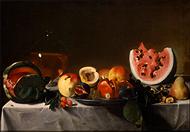 In
the third class we talked about Women and the New World.
(review this lecture) In
the third class we talked about Women and the New World.
(review this lecture)
We analyzed the impact of the discovery of the New
World on economics, social structure, and world-view. Many of the
questions and issues of the New World are explored in Aphra Behn's Oronooko.
We
will continue to talk about the patterns and images of Women in Literature
as we continue. I have also added to the Graphics
Images Chart and the Text
Chart, which you can continue to use in your ongoing research and class
project.
 Lecture
for Fifth Class: Aphra
Behn and the Proto-novel Lecture
for Fifth Class: Aphra
Behn and the Proto-novel
Women
were not allowed to write, but they were seen as attractive when they were
reading, as long as they were girls, presumably with no intent to do anything
with their knowledge!!

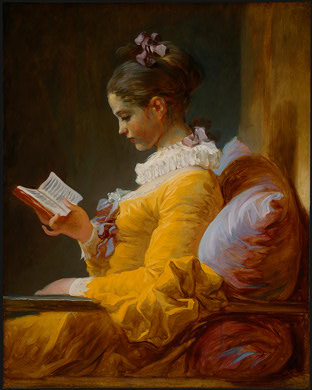
Jean-Honoré Fragonard
French, 1732 - 1806
A Young Girl Reading, c. 1776
The
novel is not considered a form that sprang "full blown" like
Aprhodite from the waves of the New World. Considerable difference of
opinion exists, still, about what qualities, finally, made the novel
complete. Oroonoko, for example, is not given the status of First
Novel in traditional studies of English Novelists--that honor is reserved
for Samuel Richardson's Pamela. However, a good case can be made that
Oronooko IS a novel, in all the senses we usually expect. In between
Aphra Behn's groundbreaking work and the very popular novels
of the 18th Century, we have some interesting Proto-Novels, at least.
And many of the popular novels were written by women.
Oronooko
- structure and narrative form
Other
Proto-Novels
Pamela
The
Gothic Ladies
The
Legacy
Oronooko
- structure and narrative form
The
narrative structure of Oronooko is unusual, not because it is one of the
earliest of the proto-novels, but because of its narrative voice and
point of view. For one thing, it seeks to create an authentic
voice. Fiction, as such, was suspect at this time. Even the
later novelists, Defoe, if you count him, and certainly Richardson, who we
will talk about, were eager to maintain the illusion
that their stories
were accurate and real accounts. This "emergence" of
fiction represented something quite new. There had been
"miracle and morality" plays in the Middle Ages, and Bunyan's
Pilgrim's Progress tends to follow that pattern - that is, the pattern of
an openly-acknowledged metaphor. Also, there was the tradition of
the "Romance," tales that were often told by wandering
story-tellers or minstrels. But again, these were openly believed to
be fanciful, fabulous tales. Don Quixote, by Miguel de Cervantes,
was a take-off on the Romance involving the wandering knight. I
believe it has all the novel qualities - all but the insistence
on a
reality-based world....
First,
we have the long, involved explanation of how our narrator comes to the
New World, a knowledgeable survey of the conditions there. Then, we
have the backstory, which reads like a "Romance" gone all
wrong. And then we have the real-time
story, the tale of Oronooko and
Imoinda in the New World, which is something else again - not romance,
although surely a tragic love story; not political tract, although surely
of political intent; and not mythic-epic, although all of the hallmarks of
the hero-epic are also present.

Other
Proto-Novels
 John Bunyan's Pilgrim's Progress (1678, 1684)
John Bunyan's Pilgrim's Progress (1678, 1684)
John Bunyan (1628-1688)
It has been said that his famous allegory about Pilgrim on his journey to the Celestial
City is second only to the Bible itself in number of copies sold through the ages and
through out the world. It is sad, however, to note that much of what Bunyan wrote is
forgotten.
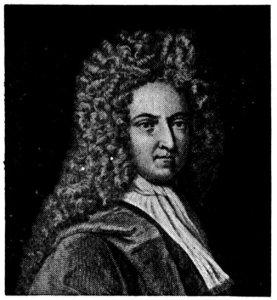
Daniel
Defoe's Robinson Crusoe ( 1719-20 ).
The Fortunes and Misfortunes of
Moll Flanders (1722)
one of the earliest novels
dealing with a poor girl.

Samuel Richardson's Pamela, the "First
Novel" according to the Canon
Samuel Richardson, 1689-1761, English novelist.
The novelist Samuel Richardson (1689-1761) built up a prosperous business as a printer, stationer and publisher
before writing and publishing
Pamela, a novel written in the form of letters. It was a great success.
Clarissa Harlowe, his best-known work, followed between 1747 and 1748.
Richardson began his career in 1706 as an apprentice printer in London, and later came to write fiction. His Pamela; or,
Virtue Rewarded (1741), an epistolary novel, is held by many to make him the originator of the English novel. His
Clarissa
(1748), one of the longest novels in the English language (and also epistolary in form), recounts the rake Lovelace's seduction of
Clarissa Harlowe and her eventual death. His last novel, Sir Charles Grandison, appeared in 1753.
Forgotten or not, the men of the
English Canon get the most press: if you look at the list of the
"canon" of literature below, you will see that women take a
sorry back seat - even the authors you have probably not heard of are all
male!!
general references on English Renaissance
and English literature from
The
British Literature Index.
John Skelton ( 1460-1529 ).
Sir Thomas More ( 1478-1535 ).
Sir Thomas Elyot ( 1490-1546 ).
John Heywood ( ?1497 - ?1580 ).
Sir Thomas Wyatt ( 1503-1542 ).
Nicholas Udall ( 1505-1556 ). The author of Ralph Roister Doister(1566), regarded as the first comedy in English literature.
Roger Ascham ( 1515-1568 ).
John Foxe ( 1517 - 1587 ).
Earl of Surrey ( 1517-1547 ).
William Painter ( 1540-1594 ). His Palace of Pleasure(1567) is a large collection of novellas by Italian and French authors such
as Boccaccio, Bandello, Marguerite of Navarre and others.
George Gascoigne ( 1542-1577 ).
Thomas Deloney ( 1543-1600 ).
Edmund Spenser ( 1552-1599 ).
Sir Walter Ralegh ( 1552-1618 ).
Richard Hakluyt ( 1552-1616 ).
Sir Philip Sidney ( 1554-1586 ).
Richard Hooker ( 1554-1600 ).
John Lyly ( 1554-1606 ).
Lancelot Andrewes ( 1555 - 1626 ).
Thomas Kyd ( 1558-1594 ).
Thomas Lodge ( 1558-1625 ).
George Chapman ( 1559-1634 ).
Robert Greene ( 1560-1592 ).
Sir Francis Bacon ( 1561-1626 ).
Samuel Daniel ( 1562-1619 ).
Michael Drayton ( 1563-1631 ).
Christopher Marlowe ( 1564-1593 ).
William Shakespeare ( 1564-1616 ).
Gorboduc ( 1565 ). The first Senecan tragedy in English and the first blank verse play. By Sackville and Norton.
Thomas Campion ( 1567-1620 ).
Thomas Nashe ( 1567-1601 ).
Thomas Dekker ( ?1572 - 1632 ).
John Donne ( 1573-1631 ).
Ben Jonson ( 1573-1637 ).
Thomas Heywood ( ?1574 - 1641 ).
Gammer Gurton's Needle ( 1575 ). The second comedy in English literature now attributed to William Stevenson, who possibly
wrote it in the early 1550's.
John Marston ( 1576 - 1634 ).
Robert Burton ( 1577 - 1640 ).
Thomas Middleton ( 1580-1627 ).
John Webster ( 1580-1625 ).
Philip Massinger ( 1583 - 1640 ).
John Fletcher ( 1579-1625 ) and Francis Beaumont ( 1584-1616 ). Click Here
Thomas Hobbes ( 1588-1679 ).
Robert Herrick ( 1591-1674 ).
Izaac Walton ( 1593-1683 ).
George Herbert ( 1593-1633 ).
Thomas Carew ( 1594-1640 ).
Sir Thomas Browne ( 1605-1682 ).
Edmund Waller ( 1606-1687 ).
John Milton ( 1608-1674 ).
Sir John Suckling ( 1609-1642 ).
Richard Crashaw ( 1613-1649 ).
Jeremy Taylor ( 1613 - 1667 ).
Abraham Cowley ( 1618-1667 ).
Richard Lovelace ( 1618-1657 ).
Andrew Marvell ( 1621-1678 ).
Henry Vaughan ( 1622-1695 ).
Thomas Traherne ( 1637-1674 ).
The Restoration, 1660-1702
Edward Hyde, First Earl of Clarendon ( 1609 - 1674 ).
Samuel Butler ( 1612-1680 ).
John Evelyn ( 1620-1706 ).
John Bunyan ( 1628-1688 ).
John Dryden ( 1631-1700 ).
John Locke ( 1632-1704 ).
Samuel Pepys ( 1633-1703 ).
Sir George Etherege ( 1634-1692 ).
Aphra Behn ( 1640-1689 ).
William Wycherley ( 1640-1715 ).
Sir Isaac Newton ( 1642-1727 ).
John Wilmot, Earl of Rochester ( 1647-1680 ).
Thomas Otway ( 1652-1685 ).
Matthew Prior ( 1664 - 1721 ).
Sir John Vanbrugh ( 1664-1726 ).
John Pomfret ( 1667 - 1702 ). "The Choice" ( 1700 ). Local HTML Text On Line. A composition that enjoyed phenomenal
popularity during the Eighteenth Century.
William Congreve ( 1670-1729 ).
Nicholas Rowe ( 1674-1718 ).
Isaac Watts ( 1674 - 1748 ).
George Farquhar ( 1677-1707 ).
The Eighteenth Century From the Accession of Queen Anne until the Death of Johnson, 1702-1784
Daniel Defoe ( 1659-1731 ).
Jonathan Swift ( 1667-1745 ).
Bernard Mandeville ( 1670 - 1733 ).
Joseph Addison ( 1672-1719 ).
Sir Richard Steele ( 1672-1729 ).
John Gay ( 1685-1732 ).
Alexander Pope ( 1688-1744 ). The premier poet of his age.
Samuel Richardson ( 1689-1761 ).
Philip Stanhope, Earl of Chesterfield ( 1694-1773 ).
James Thomson ( 1700-1748 ).
John Wesley ( 1703 - 1791 ).
Henry Fielding ( 1707-1754 ).
Samuel Johnson ( 1709-1784 ). The ultimate man of letters of the 18th Century, The Great Cham of Literature.
David Hume ( 1711 - 1777 ).
Laurence Sterne ( 1713-1768 ).
Thomas Gray ( 1716-1771 ).
Horace Walpole ( 1717-1797 ).
William Collins ( 1721-1759 ).
Tobias Smollett ( 1721-1771 ).
Christopher Smart ( 1722 - 1771 ).
Edmund Burke ( 1729-1797 ).
Oliver Goldsmith ( 1730-1774 ).
William Cowper ( 1731-1800 ).
Edward Gibbon ( 1737-1794 ).
Richard Brinsley Sheridan ( 1751-1816 ).
Fanny Burney ( 1752-1840 ).
William Godwin ( 1756-1836 ).
Ann Radcliffe ( 1764-1823 ).
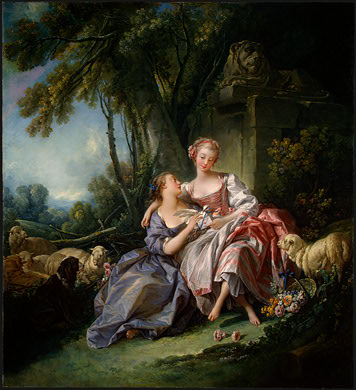
François Boucher
French, 1703 - 1770
The Love Letter, 1750
The Love Letter was commissioned by Madame de Pompadour herself. The king's
mistress ordered it and a companion painting for her chateau at Bellevue, where
they probably hung over doorways, built into curving oval frames. Pieces of canvas
were later added at the corners to make this painting rectangular.
The scene is a pastoral idyll. The young "shepherdesses" wear fine silks, and a
contemporary audience would understand an erotic promise in the display of pink
toes. Idealized visions of country life were common on the stage and in real-life
masquerades. Denis Diderot, disdainful of the frivolity of Boucher's scenes,
complained, "Shall I never be rid of these damned pastorals?" Yet the encyclopedist,
who was an influential critic, also appreciated the brilliance of Boucher's painting,
which captures the luminous colors of shells, butterflies, and polished stones --
objects the artist collected so he could copy their fragile iridescence.
Nonetheless, while women had not taken a significant
place as writers in these early years of the novel - the idea of secular
love and romance, the participation of women in society altogether, was
changing perceptibly.

Continue
with Lecture 5
|


 In
the third class we talked about
In
the third class we talked about 

 John Bunyan's Pilgrim's Progress (1678, 1684)
John Bunyan's Pilgrim's Progress (1678, 1684)


